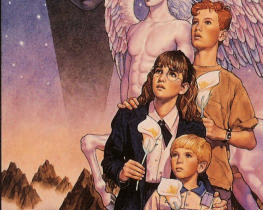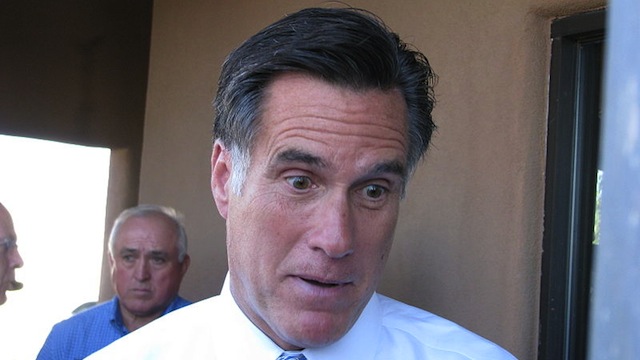Physics, Miracles, and Witchcraft: 50 Years of “A Wrinkle in Time”

It was a dark and stormy night.
By starting A Wrinkle in Time with the most famous “bad” opening in literary history—the same Edward Bulwer-Lytton line later adopted by Snoopy—Madeleine L’Engle was practically daring critics to doubt her. Even fifty years after its first publication, Wrinkle, a young adult novel that combines science fiction, fantasy, political allegory, Christian parable, and literary homage, remains easier to underestimate than categorize.
L’Engle insisted that her novel be published as a children’s book, but she nearly gave up on finding anyone willing to do so. More than two dozen houses turned it down before Farrar, Straus & Giroux took a gamble. It’s not hard to see why: how many kiddie books feature imaginative riffs on Einstein’s theories or inside jokes about Macbeth? How many feature both?
In fact this tale of physicists and witches, Genesis and general relativity conflates so many genres and worldviews in 200 pages that there’s something unassimilated about the finished product. L’Engle claimed that “it was only after it was written that I realized what some of it meant,” and while this might sound like standard authorial coyness, I actually believe her.
What she seems to have intended to do is add a new twist (wrinkle?) to C. S. Lewis’s Narnia books. Those, too, combine fantasy with a religious message; The Magician’s Nephew even includes an element of planet-hopping sci-fi. But while the Lewis of Nephew was a veteran children’s author who knew, metaphysically speaking, where he stood, the L’Engle of Wrinkle was a relative newcomer, and there’s something less slick and complacent about her universe. Blend pagan myth with Christian themes and you’re repeating an old formula; stir in large quantities of secular literature and modern science, and you get a more intriguing, more volatile chemistry.
In one scene this uneasy brew nearly bubbles over the top. Mrs. Whatsit, one of the three mysterious presences who guides Meg, Calvin, and Charles Wallace on their journey through spacetime, speaks of a cosmic battle between good and evil:
“All through the universe it’s being fought…some of our very best fighters have come right from your own planet, and it’s a little planet, dears, out on the edge of a little galaxy. You can be proud that it’s done so well.”
“Who have our fighters been?” Calvin asked.
“Oh, you must know them, dear,” Mrs. Whatsit said.
Mrs. Who’s spectacles shone out at them triumphantly, “And the light shineth in darkness; and the darkness comprehended it not.”
“Jesus!” Charles Wallace said. “Why, of course, Jesus!”
“Of course!” Mrs. Whatsit said. “Go on, Charles, love. There were others. All your great artists. They’ve been lights for us to see by.”
“Leonardo da Vinci?” Calvin suggested tentatively. “And Michelangelo?”
“And Shakespeare,” Charles Wallace called out, “and Bach! And Pasteur and Madame Curie and Einstein!”
Now Calvin’s voice rang with confidence. “And Schweitzer and Gandhi and Buddha and Beethoven and Rembrandt and St. Francis!”
“Now you, Meg,” Mrs. Whatsit ordered.
“Oh, Euclid, I suppose.” Meg was in such an agony of impatience that her voice grated irritably. “And Copernicus. But what about Father? Please, what about Father?”
This may be the single most outrageous scene in classic children’s fiction. What exactly is happening here? Evidently, L’Engle is constructing a pantheon of Earthling heroes and naming Jesus first. But is she implying that Jesus is the Light, while the others are lesser lights? Or is he just an Earthling and one of our “great artists”? Is this a Christian canon into which Gandhi and Buddha have somehow been recruited? A secular canon into which Buddha and Jesus have been recruited? An artists’ canon into which Einstein and Madame Curie have been recruited?
I don’t know, and I’m not sure L’Engle does either. I think she’s being careful, ducking accusations of parochialism, and leaving everything up to the reader’s interpretation. But I also think the variety of her idols suggests a restless imagination, one that was more confined than inspired by doctrinaire Christianity. Her impulse toward sermonizing wrestles with her impulse toward a vision that is—like her extraterrestrials and shimmering presences—unclassifiable.
L’Engle’s human characters, too, are misfits. Meg, the heroine, is flunking school yet excels at math. Her crush, Calvin, is the gentle black sheep in a family of quarreling brothers. Her brother Charles Wallace is a sort of holy child, an astonishing genius who is also, endearingly, an impatient six-year-old. As for the stations of their intergalactic journey, one is a paradise of centaurs and flowers that could belong to Lewis’s world, one a conformist dystopia (and Cold War-era allegory) that could belong to Rod Serling’s, one a council of beastlike aliens that anticipates George Lucas’s, and so on.
I loved Wrinkle as a child, and while its religiosity now grates on me slightly, several aspects of it still impress me very much. One is L’Engle’s creation of a family that is loving but not boring. Mrs. Murry, the beautiful, wistful chemist with a home laboratory; Charles Wallace, the prodigy shrugging off his daily schooyard beatings, eating liverwurst sandwiches and masterminding adventures; the dog named Fortinbras—all this is exemplary eccentricity, and adds up to one of those fictional homes for which I sometimes feel a nostalgic twinge. Another strength is L’Engle’s handling of mystery. Just before the journey begins, Meg and Calvin are about to kiss (maybe!), and little Charles Wallace appears:
“Okay, hold it, you two,” came a voice out of the shadows. Charles Wallace stepped into the moonlight. “I wasn’t spying on you,” he said quickly, “and I hate to break things up, but this is it, kids, this is it!” His voice quivered with excitement.
“This is what?” Calvin asked.
“We’re going.”
“Going? Where?” Meg reached out and instinctively grabbed for Calvin’s hand.
“I don’t know exactly,” Charles Wallace said. “But I think it’s to find Father.”
I still find this both funny and a little thrilling.
Finally, there is Mrs. Who’s habit of quoting from Western literature in order to translate her unearthly thoughts. Along the journey she drops aphorisms from Shakespeare, Dante, Goethe, Pascal, even Euripides. Not only does this device expand the book’s interpretive possibilities, it also situates literature within the universe of mysteries to which kids will someday be initiated. Perhaps it even makes a modest case for Wrinkle’s inclusion in the literary pantheon, in the same wing that includes Tom Sawyer and The Hobbit. I vote we carve out a niche for it, if only on the principle that any truly daring experiment deserves one.
[Image courtesy Amazon.com. From the 1973 Dell Yearling edition, cover art copyright Jody Lee.]





